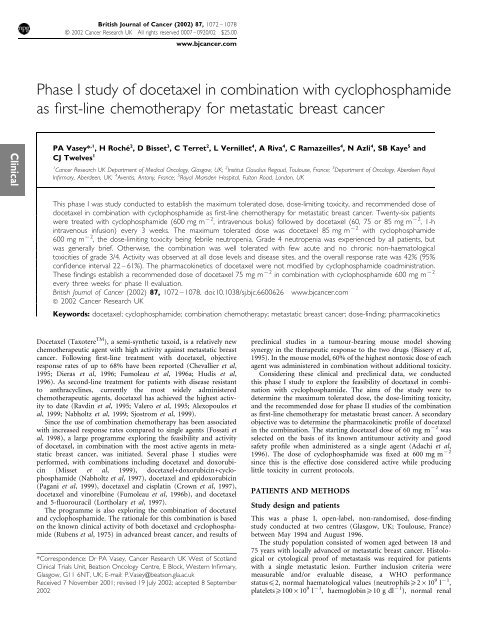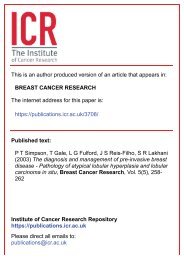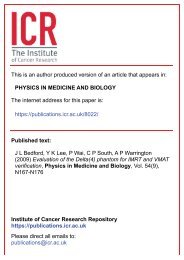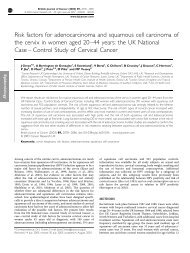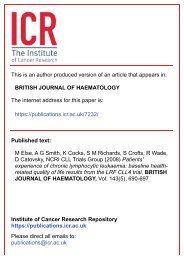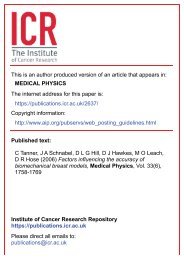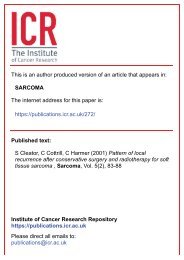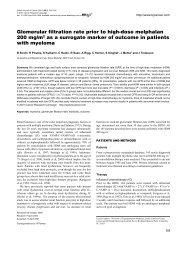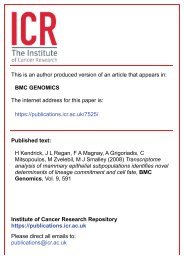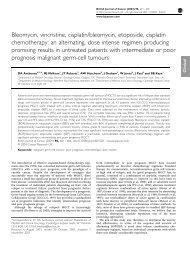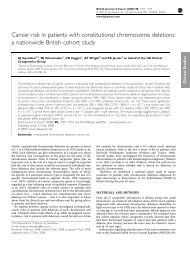Phase I study of docetaxel in combination with cyclophosphamide ...
Phase I study of docetaxel in combination with cyclophosphamide ...
Phase I study of docetaxel in combination with cyclophosphamide ...
You also want an ePaper? Increase the reach of your titles
YUMPU automatically turns print PDFs into web optimized ePapers that Google loves.
British Journal <strong>of</strong> Cancer (2002) 87, 1072 – 1078<br />
ª 2002 Cancer Research UK All rights reserved 0007 – 0920/02 $25.00<br />
www.bjcancer.com<br />
<strong>Phase</strong> I <strong>study</strong> <strong>of</strong> <strong>docetaxel</strong> <strong>in</strong> comb<strong>in</strong>ation <strong>with</strong> <strong>cyclophosphamide</strong><br />
as first-l<strong>in</strong>e chemotherapy for metastatic breast cancer<br />
Cl<strong>in</strong>ical<br />
PA Vasey* ,1 , H Roché 2 , D Bisset 3 , C Terret 2 , L Vernillet 4 , A Riva 4 , C Ramazeilles 4 , N Azli 4 , SB Kaye 5 and<br />
CJ Twelves 1<br />
1 Cancer Research UK Department <strong>of</strong> Medical Oncology, Glasgow, UK; 2 Institut Claudius Regaud, Toulouse, France; 3 Department <strong>of</strong> Oncology, Aberdeen Royal<br />
Infirmary, Aberdeen, UK;<br />
4 Aventis, Antony, France;<br />
5 Royal Marsden Hospital, Fulton Road, London, UK<br />
This phase I was <strong>study</strong> conducted to establish the maximum tolerated dose, dose-limit<strong>in</strong>g toxicity, and recommended dose <strong>of</strong><br />
<strong>docetaxel</strong> <strong>in</strong> comb<strong>in</strong>ation <strong>with</strong> <strong>cyclophosphamide</strong> as first-l<strong>in</strong>e chemotherapy for metastatic breast cancer. Twenty-six patients<br />
were treated <strong>with</strong> <strong>cyclophosphamide</strong> (600 mg m 72 , <strong>in</strong>travenous bolus) followed by <strong>docetaxel</strong> (60, 75 or 85 mg m 72 , 1-h<br />
<strong>in</strong>travenous <strong>in</strong>fusion) every 3 weeks. The maximum tolerated dose was <strong>docetaxel</strong> 85 mg m 72 <strong>with</strong> <strong>cyclophosphamide</strong><br />
600 mg m 72 , the dose-limit<strong>in</strong>g toxicity be<strong>in</strong>g febrile neutropenia. Grade 4 neutropenia was experienced by all patients, but<br />
was generally brief. Otherwise, the comb<strong>in</strong>ation was well tolerated <strong>with</strong> few acute and no chronic non-haematological<br />
toxicities <strong>of</strong> grade 3/4. Activity was observed at all dose levels and disease sites, and the overall response rate was 42% (95%<br />
confidence <strong>in</strong>terval 22 – 61%). The pharmacok<strong>in</strong>etics <strong>of</strong> <strong>docetaxel</strong> were not modified by <strong>cyclophosphamide</strong> coadm<strong>in</strong>istration.<br />
These f<strong>in</strong>d<strong>in</strong>gs establish a recommended dose <strong>of</strong> <strong>docetaxel</strong> 75 mg m 72 <strong>in</strong> comb<strong>in</strong>ation <strong>with</strong> <strong>cyclophosphamide</strong> 600 mg m 72<br />
every three weeks for phase II evaluation.<br />
British Journal <strong>of</strong> Cancer (2002) 87, 1072 – 1078. doi:10.1038/sj.bjc.6600626 www.bjcancer.com<br />
ª 2002 Cancer Research UK<br />
Keywords: <strong>docetaxel</strong>; <strong>cyclophosphamide</strong>; comb<strong>in</strong>ation chemotherapy; metastatic breast cancer; dose-f<strong>in</strong>d<strong>in</strong>g; pharmacok<strong>in</strong>etics<br />
Docetaxel (Taxotere TM ), a semi-synthetic taxoid, is a relatively new<br />
chemotherapeutic agent <strong>with</strong> high activity aga<strong>in</strong>st metastatic breast<br />
cancer. Follow<strong>in</strong>g first-l<strong>in</strong>e treatment <strong>with</strong> <strong>docetaxel</strong>, objective<br />
response rates <strong>of</strong> up to 68% have been reported (Chevallier et al,<br />
1995; Dieras et al, 1996; Fumoleau et al, 1996a; Hudis et al,<br />
1996). As second-l<strong>in</strong>e treatment for patients <strong>with</strong> disease resistant<br />
to anthracycl<strong>in</strong>es, currently the most widely adm<strong>in</strong>istered<br />
chemotherapeutic agents, <strong>docetaxel</strong> has achieved the highest activity<br />
to date (Ravd<strong>in</strong> et al, 1995; Valero et al, 1995; Alexopoulos et<br />
al, 1999; Nabholtz et al, 1999; Sjostrom et al, 1999).<br />
S<strong>in</strong>ce the use <strong>of</strong> comb<strong>in</strong>ation chemotherapy has been associated<br />
<strong>with</strong> <strong>in</strong>creased response rates compared to s<strong>in</strong>gle agents (Fossati et<br />
al, 1998), a large programme explor<strong>in</strong>g the feasibility and activity<br />
<strong>of</strong> <strong>docetaxel</strong>, <strong>in</strong> comb<strong>in</strong>ation <strong>with</strong> the most active agents <strong>in</strong> metastatic<br />
breast cancer, was <strong>in</strong>itiated. Several phase I studies were<br />
performed, <strong>with</strong> comb<strong>in</strong>ations <strong>in</strong>clud<strong>in</strong>g <strong>docetaxel</strong> and doxorubic<strong>in</strong><br />
(Misset et al, 1999), <strong>docetaxel</strong>+doxorubic<strong>in</strong>+<strong>cyclophosphamide</strong><br />
(Nabholtz et al, 1997), <strong>docetaxel</strong> and epidoxorubic<strong>in</strong><br />
(Pagani et al, 1999), <strong>docetaxel</strong> and cisplat<strong>in</strong> (Crown et al, 1997),<br />
<strong>docetaxel</strong> and v<strong>in</strong>orelb<strong>in</strong>e (Fumoleau et al, 1996b), and <strong>docetaxel</strong><br />
and 5-fluorouracil (Lortholary et al, 1997).<br />
The programme is also explor<strong>in</strong>g the comb<strong>in</strong>ation <strong>of</strong> <strong>docetaxel</strong><br />
and <strong>cyclophosphamide</strong>. The rationale for this comb<strong>in</strong>ation is based<br />
on the known cl<strong>in</strong>ical activity <strong>of</strong> both <strong>docetaxel</strong> and <strong>cyclophosphamide</strong><br />
(Rubens et al, 1975) <strong>in</strong> advanced breast cancer, and results <strong>of</strong><br />
*Correspondence: Dr PA Vasey, Cancer Research UK West <strong>of</strong> Scotland<br />
Cl<strong>in</strong>ical Trials Unit, Beatson Oncology Centre, E Block, Western Infirmary,<br />
Glasgow, G11 6NT, UK; E-mail: P.Vasey@beatson.gla.ac.uk<br />
Received 7 November 2001; revised 19 July 2002; accepted 8 September<br />
2002<br />
precl<strong>in</strong>ical studies <strong>in</strong> a tumour-bear<strong>in</strong>g mouse model show<strong>in</strong>g<br />
synergy <strong>in</strong> the therapeutic response to the two drugs (Bissery et al,<br />
1995). In the mouse model, 60% <strong>of</strong> the highest nontoxic dose <strong>of</strong> each<br />
agent was adm<strong>in</strong>istered <strong>in</strong> comb<strong>in</strong>ation <strong>with</strong>out additional toxicity.<br />
Consider<strong>in</strong>g these cl<strong>in</strong>ical and precl<strong>in</strong>ical data, we conducted<br />
this phase I <strong>study</strong> to explore the feasibility <strong>of</strong> <strong>docetaxel</strong> <strong>in</strong> comb<strong>in</strong>ation<br />
<strong>with</strong> <strong>cyclophosphamide</strong>. The aims <strong>of</strong> the <strong>study</strong> were to<br />
determ<strong>in</strong>e the maximum tolerated dose, the dose-limit<strong>in</strong>g toxicity,<br />
and the recommended dose for phase II studies <strong>of</strong> the comb<strong>in</strong>ation<br />
as first-l<strong>in</strong>e chemotherapy for metastatic breast cancer. A secondary<br />
objective was to determ<strong>in</strong>e the pharmacok<strong>in</strong>etic pr<strong>of</strong>ile <strong>of</strong> <strong>docetaxel</strong><br />
<strong>in</strong> the comb<strong>in</strong>ation. The start<strong>in</strong>g <strong>docetaxel</strong> dose <strong>of</strong> 60 mg m 72 was<br />
selected on the basis <strong>of</strong> its known antitumour activity and good<br />
safety pr<strong>of</strong>ile when adm<strong>in</strong>istered as a s<strong>in</strong>gle agent (Adachi et al,<br />
1996). The dose <strong>of</strong> <strong>cyclophosphamide</strong> was fixed at 600 mg m 72<br />
s<strong>in</strong>ce this is the effective dose considered active while produc<strong>in</strong>g<br />
little toxicity <strong>in</strong> current protocols.<br />
PATIENTS AND METHODS<br />
Study design and patients<br />
This was a phase I, open-label, non-randomised, dose-f<strong>in</strong>d<strong>in</strong>g<br />
<strong>study</strong> conducted at two centres (Glasgow, UK; Toulouse, France)<br />
between May 1994 and August 1996.<br />
The <strong>study</strong> population consisted <strong>of</strong> women aged between 18 and<br />
75 years <strong>with</strong> locally advanced or metastatic breast cancer. Histological<br />
or cytological pro<strong>of</strong> <strong>of</strong> metastasis was required for patients<br />
<strong>with</strong> a s<strong>in</strong>gle metastatic lesion. Further <strong>in</strong>clusion criteria were<br />
measurable and/or evaluable disease, a WHO performance<br />
status42, normal haematological values (neutrophils52610 9 l 71 ,<br />
platelets5100610 9 l 71 , haemoglob<strong>in</strong>510 g dl 71 ), normal renal
function (creat<strong>in</strong><strong>in</strong>e4140 mmol l 71 , creat<strong>in</strong><strong>in</strong>e clearance 60 ml<br />
m<strong>in</strong> 71 ), and normal liver function test (bilirub<strong>in</strong>41.25 times the<br />
upper limit <strong>of</strong> the <strong>in</strong>stitutional normal value [N]; for the highest<br />
dose level only [<strong>docetaxel</strong> 100 mg m 72 and <strong>cyclophosphamide</strong><br />
600 mg m 72 ], alan<strong>in</strong>e and aspartate am<strong>in</strong>otransferases43N, alkal<strong>in</strong>e<br />
phosphatase45N).<br />
Patients were excluded if they had received previous chemotherapy<br />
for metastatic disease. However, prior neoadjuvant and<br />
adjuvant treatments were permitted provided there had been a<br />
chemotherapy-free <strong>in</strong>terval <strong>of</strong> at least 6 months before <strong>study</strong> entry.<br />
Hormonal therapies as adjuvant treatment and/or for metastatic<br />
disease (42) were also allowed provided there was a 4-week <strong>in</strong>terval<br />
between the last hormonal treatment and <strong>study</strong> entry <strong>in</strong><br />
patients who achieved a response (no time <strong>in</strong>terval was required<br />
for patients <strong>with</strong> no response). Radiotherapy given at least 4 weeks<br />
previously was permitted except at sites used to assess response <strong>in</strong><br />
this <strong>study</strong>. For all previous antitumour therapies, patients must<br />
have fully recovered from any toxic effects. Patients were <strong>in</strong>eligible<br />
if they had received previous treatment <strong>with</strong> <strong>docetaxel</strong>, paclitaxel,<br />
or colony-stimulat<strong>in</strong>g factors.<br />
Further exclusion criteria were pregnancy, lactation, or childbear<strong>in</strong>g<br />
potential (e.g. not us<strong>in</strong>g adequate contraception); a history<br />
<strong>of</strong> prior malignancies, <strong>with</strong> the exceptions <strong>of</strong> non-melanoma sk<strong>in</strong><br />
cancer and well excised cervical carc<strong>in</strong>oma <strong>in</strong> situ; known cl<strong>in</strong>ical<br />
bra<strong>in</strong> or leptomen<strong>in</strong>geal <strong>in</strong>volvement; symptomatic peripheral<br />
neuropathy <strong>of</strong> grade 52; other serious illnesses and medical conditions;<br />
and participation <strong>in</strong> another cl<strong>in</strong>ical <strong>study</strong> either dur<strong>in</strong>g the<br />
<strong>study</strong> or <strong>with</strong><strong>in</strong> 30 days <strong>of</strong> <strong>study</strong> entry. For the highest dose level<br />
(<strong>docetaxel</strong> 100 mg m 72 and <strong>cyclophosphamide</strong> 600 mg m 72 ),<br />
impaired liver function <strong>with</strong> alan<strong>in</strong>e and aspartate am<strong>in</strong>otransferases<br />
41.5 N associated <strong>with</strong> alkal<strong>in</strong>e phosphatase 42.5 N was<br />
also an exclusion criterion.<br />
The <strong>study</strong> was conducted <strong>in</strong> accordance <strong>with</strong> the Declaration <strong>of</strong><br />
Hels<strong>in</strong>ki, <strong>in</strong> compliance <strong>with</strong> local regulations, and <strong>with</strong> the<br />
approval <strong>of</strong> an <strong>in</strong>dependent Ethics Committee at each centre. All<br />
patients gave written, <strong>in</strong>formed consent to participate <strong>in</strong> the <strong>study</strong>.<br />
Treatment plan<br />
Four escalat<strong>in</strong>g dose levels <strong>of</strong> <strong>docetaxel</strong> and <strong>cyclophosphamide</strong><br />
were planned (Table 1). Cyclophosphamide was to be adm<strong>in</strong>istered<br />
at a fixed dose (600 mg m 72 , <strong>in</strong>travenous bolus) followed by <strong>docetaxel</strong>,<br />
<strong>with</strong>out recomb<strong>in</strong>ant human granulocyte colony-stimulat<strong>in</strong>g<br />
factor (rHuG-CSF) prophylaxis, at <strong>in</strong>creas<strong>in</strong>g doses (60, 75, 85 and<br />
100 mg m 72 ; 1-h <strong>in</strong>travenous <strong>in</strong>fusion) every 3 weeks <strong>in</strong> successive<br />
groups <strong>of</strong> patients. The order <strong>of</strong> drug adm<strong>in</strong>istration was chosen<br />
based on prelim<strong>in</strong>ary data from a phase I <strong>study</strong> exam<strong>in</strong><strong>in</strong>g comb<strong>in</strong>ation<br />
therapy <strong>with</strong> paclitaxel (135 mg m 72 start<strong>in</strong>g dose) and<br />
<strong>cyclophosphamide</strong> (750 mg m 72 fixed dose) (Kennedy et al,<br />
1993). The <strong>study</strong> explored both <strong>cyclophosphamide</strong> followed by<br />
paclitaxel and the reverse sequence. The results <strong>in</strong>dicated that<br />
haematological toxicity was sequence-dependent: the median<br />
neutrophil nadir was lower <strong>with</strong> paclitaxel given first (9646<br />
10 6 l 71 ) than <strong>with</strong> <strong>cyclophosphamide</strong> given first (1864610 6 l 71 ).<br />
Table 1 Planned dose levels <strong>of</strong> <strong>cyclophosphamide</strong> and <strong>docetaxel</strong>, each<br />
given once every 3 weeks<br />
Cyclophosphamide<br />
Docetaxel<br />
Dose level (mg m 72 ) (mg m 72 )<br />
I 600 60<br />
II 600 75<br />
III 600 85<br />
IV 600 100<br />
Docetaxel <strong>with</strong> <strong>cyclophosphamide</strong> for metastatic breast cancer<br />
PA Vasey et al<br />
To avoid hypersensitivity reactions and <strong>docetaxel</strong>-related sk<strong>in</strong><br />
toxicity and fluid retention, all patients were given a 3-day corticosteroid<br />
prophylactic premedication, start<strong>in</strong>g the day before<br />
chemotherapy: oral dexamethasone (20 mg) and ranitid<strong>in</strong>e<br />
(150 mg) were adm<strong>in</strong>istered 3 and 12 h before <strong>docetaxel</strong> <strong>in</strong>fusion<br />
and at 0, 12, 24 and 36 h post-<strong>in</strong>fusion, and oral chlorpheniram<strong>in</strong>e<br />
(8 mg) was given at 3 and 12 h before <strong>docetaxel</strong> <strong>in</strong>fusion.<br />
Treatment was planned for six cycles unless there was evidence<br />
<strong>of</strong> disease progression, unacceptable toxicity, patient refusal, or no<br />
symptomatic improvement after three cycles. Treatment thereafter<br />
depended on the tumour response dur<strong>in</strong>g the first six cycles.<br />
Patients <strong>with</strong> an objective response could cont<strong>in</strong>ue treatment until<br />
disease progression, serious toxicity, or patient refusal occurred.<br />
Patients <strong>with</strong> stable disease after six cycles or progression at any<br />
time were <strong>with</strong>drawn and received salvage treatment at the discretion<br />
<strong>of</strong> the <strong>in</strong>vestigator.<br />
Dose levels were assigned at recruitment and no dose escalation<br />
was allowed <strong>with</strong><strong>in</strong> the same patient. The protocol stipulated that<br />
at least three patients should be treated at each dose level, <strong>with</strong> a<br />
1-week <strong>in</strong>terval between entry <strong>of</strong> the first patient and the next<br />
two patients. Before escalat<strong>in</strong>g to the next dose level, at least two<br />
patients should have received at least two cycles and have been<br />
observed for acute toxicity for a m<strong>in</strong>imum <strong>of</strong> 2 weeks. If one<br />
out <strong>of</strong> the three patients at the same dose level developed doselimit<strong>in</strong>g<br />
toxicity, three more patients were to be entered at the<br />
same dose level. The maximum tolerated dose was def<strong>in</strong>ed as the<br />
dose level at which at least two out <strong>of</strong> the six patients developed<br />
a dose-limit<strong>in</strong>g toxicity. The recommended dose was def<strong>in</strong>ed as<br />
the dose level previous to the maximum tolerated dose. For all<br />
dose levels tested, more than three patients were recruited, <strong>in</strong> order<br />
to ascerta<strong>in</strong> the safety pr<strong>of</strong>ile <strong>in</strong> a larger sample size.<br />
Toxicity was graded accord<strong>in</strong>g to National Cancer Institute<br />
Common Toxicity Criteria (NCI-CTC) current at the start <strong>of</strong> the<br />
<strong>study</strong>. Dose-limit<strong>in</strong>g toxicities were def<strong>in</strong>ed as: grade 4 neutropenia<br />
(neutrophil count 50.5610 9 l 71 ) for 47 days; febrile neutropenia<br />
(grade 4 neutropenia concomitant <strong>with</strong> grade 52 fever);<br />
grade 4 thrombocytopenia (platelet count 525610 9 l 71 ); grade<br />
3/4 bleed<strong>in</strong>g or <strong>in</strong>fection; grade 4 nausea/vomit<strong>in</strong>g; grade 2 neurological<br />
toxicity; and any other grade 3/4 toxicities, except alopecia<br />
and anaemia. Non-recovery <strong>of</strong> the neutrophil count (to<br />
51.5610 9 l 71 ) or platelet count (to 5100610 9 l 71 ) on day 21<br />
<strong>of</strong> each cycle were further dose-limit<strong>in</strong>g toxicities.<br />
Dose modifications were planned for haematological and nonhaematological<br />
toxicity. Except for grade 3 neuropathy, for which<br />
patients were <strong>with</strong>drawn, <strong>in</strong> the event <strong>of</strong> dose-limit<strong>in</strong>g toxicity,<br />
treatment was delayed until recovery to grade 1 then restarted<br />
usually at the dose level below or modified as appropriate to the<br />
toxicity. If, despite the corticosteroid prophylactic premedication,<br />
a hypersensitivity reaction developed, the symptoms were treated<br />
appropriately, for example <strong>with</strong> ep<strong>in</strong>ephr<strong>in</strong>e for anaphylactic shock<br />
and am<strong>in</strong>ophyll<strong>in</strong>e for bronchospasm. No dose modification was<br />
planned for localised or peripheral oedema, but the patient could<br />
be <strong>with</strong>drawn at the discretion <strong>of</strong> the <strong>in</strong>vestigator. Antiemetic<br />
prophylaxis (metoclopramide or domperidone) could be given<br />
from the first cycle onwards, and loperamide to prevent diarrhoea<br />
<strong>in</strong> subsequent cycles follow<strong>in</strong>g grade 2/3 diarrhoea; patients <strong>with</strong><br />
nausea or diarrhoea despite these measures could be treated <strong>with</strong><br />
granisetron or odansetron, but additional treatment <strong>with</strong> corticosteroids<br />
was not allowed.<br />
Patient and treatment evaluation<br />
Pre<strong>study</strong> evaluations <strong>in</strong>cluded a medical history and physical exam<strong>in</strong>ation,<br />
an electrocardiogram, radiology exam<strong>in</strong>ations (bilateral<br />
mammography, chest X-ray or CT scan, abdom<strong>in</strong>al ultrasound<br />
or CT scan, bone scan, and <strong>in</strong>strumental exam<strong>in</strong>ations as appropriate<br />
for any other measurable and/or evaluable disease), a complete<br />
1073<br />
Cl<strong>in</strong>ical<br />
ª 2002 Cancer Research UK British Journal <strong>of</strong> Cancer (2002) 87(10), 1072 – 1078
Cl<strong>in</strong>ical<br />
1074<br />
Docetaxel <strong>with</strong> <strong>cyclophosphamide</strong> for metastatic breast cancer<br />
PA Vasey et al<br />
blood count (white blood cells <strong>with</strong> differential, platelets, haemoglob<strong>in</strong>),<br />
a biochemistry pr<strong>of</strong>ile, a basel<strong>in</strong>e toxicity evaluation, and<br />
other <strong>in</strong>vestigations as cl<strong>in</strong>ically <strong>in</strong>dicated.<br />
Patients were monitored regularly for toxicity, and were asked to<br />
report any cl<strong>in</strong>ical adverse events to the <strong>in</strong>vestigator. Haematological<br />
assessments were made twice weekly, or every 2 days <strong>in</strong> cases <strong>of</strong><br />
febrile neutropenia until recovery to grade41 neutropenia and<br />
resolution <strong>of</strong> all <strong>in</strong>fectious symptoms. Irrespective <strong>of</strong> the reason<br />
for treatment discont<strong>in</strong>uation, patients were observed dur<strong>in</strong>g the<br />
first month after the last cycle <strong>of</strong> treatment <strong>in</strong> order to monitor<br />
any late adverse events.<br />
Tumour response was assessed accord<strong>in</strong>g to WHO criteria (Miller<br />
et al, 1981). The duration <strong>of</strong> a partial response dated from the<br />
start <strong>of</strong> treatment until the first documentation <strong>of</strong> progressive<br />
disease, while the duration <strong>of</strong> a complete response was from the<br />
time it was first documented. The time to first response and time<br />
to progression were from the start <strong>of</strong> <strong>study</strong> treatment to the first<br />
occurrence <strong>of</strong> response and first progression, respectively. Survival<br />
dated from the start <strong>of</strong> treatment.<br />
Pharmacok<strong>in</strong>etic analysis<br />
The pharmacok<strong>in</strong>etics <strong>of</strong> <strong>docetaxel</strong> were evaluated dur<strong>in</strong>g the first<br />
cycle only, whereas the pharmacok<strong>in</strong>etics <strong>of</strong> <strong>cyclophosphamide</strong><br />
were not determ<strong>in</strong>ed. Blood samples were collected before <strong>in</strong>travenous<br />
<strong>in</strong>fusion <strong>of</strong> <strong>docetaxel</strong>, at 30 m<strong>in</strong> after the start <strong>of</strong> <strong>in</strong>fusion, at<br />
the end <strong>of</strong> <strong>in</strong>fusion, and at 5, 10, 20, 30, 60, 90 m<strong>in</strong> and 2, 4, 6, 8,<br />
12, 16, 24, 36, 48 and 72 h post-<strong>in</strong>fusion. Plasma <strong>docetaxel</strong> concentrations<br />
were measured by high-performance liquid<br />
chromatography, us<strong>in</strong>g a C18 reversed-phase column and ultraviolet<br />
detection at 225 nm (Vergniol et al, 1992). The lower<br />
quantification limit <strong>of</strong> this assay was 10 ng ml 71 . Pharmacok<strong>in</strong>etic<br />
parameters were estimated by nonl<strong>in</strong>ear least square regression<br />
analysis us<strong>in</strong>g W<strong>in</strong>Nonl<strong>in</strong> s<strong>of</strong>tware (Scientific Consult<strong>in</strong>g Inc,<br />
USA) and a two- or three-compartment open model <strong>with</strong> firstorder<br />
elim<strong>in</strong>ation.<br />
The follow<strong>in</strong>g parameters were calculated: the maximum plasma<br />
concentration (C max ), the area under the plasma concentrationtime<br />
curve (AUC[0-]), total body clearance (CL), the volume<br />
<strong>of</strong> distribution at steady state (V ss ), and the term<strong>in</strong>al elim<strong>in</strong>ation<br />
half-life (t ½z ).<br />
RESULTS<br />
Patient characteristics<br />
Twenty-six patients <strong>with</strong> previously untreated metastatic breast<br />
cancer were enrolled <strong>in</strong>to the <strong>study</strong> (Table 2). The median age<br />
was 56 years and the median WHO performance status was 1.<br />
Eighteen patients (69%) had two or more <strong>in</strong>volved organs; 12<br />
(46%) had visceral <strong>in</strong>volvement, and bone and lymph nodes were<br />
the most frequent disease sites (both 13 patients; 50%). Oestrogen<br />
receptor status was performed <strong>in</strong> only n<strong>in</strong>e patients; six were ER<br />
negative, three ER positive. Progesterone receptor status was not<br />
assessed <strong>in</strong> any patient. Thirteen patients (50%) had received<br />
previous adjuvant and/or neoadjuvant chemotherapy, <strong>with</strong> an<br />
anthracyl<strong>in</strong>e-based regimen <strong>in</strong> six patients (23%). Sixteen patients<br />
had received adjuvant hormonal therapy, 16 as treatment for metastatic<br />
disease, and n<strong>in</strong>e received hormonal therapy both <strong>in</strong> the<br />
adjuvant and metastatic sett<strong>in</strong>g. N<strong>in</strong>eteen patients (73%) had at<br />
least one bidimensionally measurable lesion, while the rema<strong>in</strong><strong>in</strong>g<br />
seven patients (27%) had only evaluable disease.<br />
Chemotherapy adm<strong>in</strong>istration<br />
In total, 144 cycles <strong>of</strong> chemotherapy were adm<strong>in</strong>istered dur<strong>in</strong>g the<br />
<strong>study</strong> (Table 3). The median number <strong>of</strong> cycles per patient was six<br />
Table 2<br />
(range 2 – 9). At least four cycles were given to 20 patients (77%),<br />
six cycles to 17 patients (65%), and eight cycles to six patients<br />
(23%). The median cumulative doses <strong>of</strong> <strong>docetaxel</strong> and <strong>cyclophosphamide</strong><br />
were 438 mg m 72 (range 149 – 736 mg m 72 ) and<br />
3541 mg m 72 (range 1184 – 5432 mg m 72 ), respectively. The<br />
median relative dose <strong>in</strong>tensity was 0.98 for each <strong>of</strong> <strong>docetaxel</strong>, <strong>cyclophosphamide</strong>,<br />
and the comb<strong>in</strong>ation.<br />
Most treatment cycles (135; 94%) were adm<strong>in</strong>istered every 3<br />
weeks as planned. Only n<strong>in</strong>e cycles (6%) were delayed and seven<br />
delays lasted for no longer than 1 week. Dose modification was<br />
required for six cycles (4%). Five delays and five dose modifications<br />
were due to toxicity; the rema<strong>in</strong>der were because <strong>of</strong> nonmedical<br />
reasons.<br />
Safety<br />
Patient and disease characteristics at basel<strong>in</strong>e<br />
Patient demographics<br />
Characteristic n a (%) a<br />
Number <strong>of</strong> patients 26<br />
Age (years)<br />
median 56<br />
range 42 – 69<br />
WHO performance status (grade)<br />
median 1<br />
range 0 – 2<br />
Measurability <strong>of</strong> disease<br />
bidimensional 19 (73.1%)<br />
evaluable 7 (26.9%)<br />
Number <strong>of</strong> organs <strong>in</strong>volved<br />
1 8 (30.8%)<br />
2 10 (38.5%)<br />
53 8 (30.8%)<br />
Visceral <strong>in</strong>volvement 12 (46.2%)<br />
Disease sites<br />
bone 13 (50.0%)<br />
lymph node 13 (50.0%)<br />
chest wall 8 (30.8%)<br />
lung 6 (23.1%)<br />
liver 5 (19.2%)<br />
breast 4 (15.4%)<br />
sk<strong>in</strong> 2 (7.7%)<br />
pleural 2 (7.7%)<br />
peritoneum 2 (7.7%)<br />
Prior chemotherapy<br />
total 13 (50.0%)<br />
<strong>with</strong> anthracycl<strong>in</strong>es 6 (23.1%)<br />
a Unless otherwise stated.<br />
All 26 patients were evaluable for safety. Overall, the toxicities seen<br />
at all dose levels were usually haematological and <strong>of</strong> short duration,<br />
and were rarely severe or non-haematological. Fourteen patients<br />
(54%) discont<strong>in</strong>ued the <strong>study</strong> after they had completed the<br />
planned six cycles <strong>of</strong> treatment. Of the 12 patients (46%) who<br />
discont<strong>in</strong>ued treatment earlier, 10 <strong>with</strong>drew due to disease progression;<br />
one patient (at the <strong>docetaxel</strong> 75 mg m 72 dose level)<br />
<strong>with</strong>drew due to moderate fluid etention that was observed at cycle<br />
5 and after a cumulative <strong>docetaxel</strong> dose <strong>of</strong> 288 mg m 72 . One<br />
patient at the <strong>docetaxel</strong> 60 mg m 72 dose level died secondary to<br />
perforation <strong>of</strong> the ascend<strong>in</strong>g colon complicated by peritonitis.<br />
The patient had been tak<strong>in</strong>g non-steroidal anti-<strong>in</strong>flammatory drugs<br />
(NSAIDs) <strong>in</strong> addition to her corticosteroids, and presented <strong>with</strong><br />
haematemesis. She was neutropenic (0.46610 9 l 71 ) but typhlitis<br />
was not suspected because <strong>of</strong> the cl<strong>in</strong>ical presentation and the<br />
British Journal <strong>of</strong> Cancer (2002) 87(10), 1072 – 1078<br />
ª 2002 Cancer Research UK
absence <strong>of</strong> prolonged granulocytopenia. However, a post-mortem<br />
exam<strong>in</strong>ation was not carried out.<br />
As expected <strong>with</strong> these two myelosuppressive drugs, neutropenia<br />
and its complications were the most frequent adverse events (Table<br />
4). Grade 4 neutropenia developed <strong>in</strong> all patients and its <strong>in</strong>cidence<br />
by cycle was highest at the <strong>docetaxel</strong> 85 mg m 72 dose level. The<br />
grade 4 neutropenia was, however, generally brief, <strong>with</strong> a median<br />
duration <strong>of</strong> 5 to 7 days and a median time to nadir <strong>of</strong> 7 to 8 days<br />
across the dose levels. At day 22+3, the median neutrophil count<br />
was 54.9610 9 l 71 at all dose levels. Febrile neutropenia was<br />
def<strong>in</strong>ed broadly, as grade 4 neutropenia concomitant <strong>with</strong> grade<br />
52 fever, and occurred <strong>in</strong> n<strong>in</strong>e patients (35%; 7% <strong>of</strong> cycles).<br />
The highest <strong>in</strong>cidence was observed at the <strong>docetaxel</strong> 85 mg m 72<br />
dose level (eight patients). However, at this dose level, only one<br />
patient developed a documented grade 3/4 <strong>in</strong>fection (grade 3 ur<strong>in</strong>ary<br />
<strong>in</strong>fection at cycle 2).<br />
Although anaemia was noted <strong>in</strong> all patients (eight grade 1, 14<br />
grade 2, four grade 3), no grade 4 episode occurred. Eight patients<br />
(31%) required a blood transfusion dur<strong>in</strong>g the <strong>study</strong>. Thrombocytopaenia<br />
was uncommon, occurr<strong>in</strong>g <strong>in</strong> four patients (15%), and no<br />
patient experienced a grade 3/4 episode or required a platelet transfusion.<br />
The most common acute non-haematological toxicities considered<br />
to be possibly or probably related to <strong>study</strong> treatment were<br />
nausea, stomatitis, diarrhoea, and vomit<strong>in</strong>g (Table 5). Episodes<br />
were usually grade 1/2; only a few grade 3/4 episodes were observed<br />
dur<strong>in</strong>g the <strong>study</strong>. Alopecia was universal. Asthenia and fluid retention<br />
were frequent (each 50% <strong>of</strong> patients), but were never severe.<br />
One patient discont<strong>in</strong>ued the <strong>study</strong> due to moderate fluid retention.<br />
The other <strong>docetaxel</strong>-related chronic toxicities (i.e. sk<strong>in</strong><br />
toxicity and nail disorders) were <strong>in</strong>frequent and never severe.<br />
Maximum tolerated and recommended doses<br />
The maximum tolerated dose <strong>of</strong> the comb<strong>in</strong>ation was reached at<br />
the <strong>docetaxel</strong> 85 mg m 72 dose level. Of the 13 patients treated<br />
at this dose level, six developed dose-limit<strong>in</strong>g toxicity, as a result<br />
<strong>of</strong> febrile neutropenia (five patients) or grade three <strong>in</strong>fection<br />
(one patient). The dose-limit<strong>in</strong>g toxicity <strong>of</strong> the comb<strong>in</strong>ation was<br />
Docetaxel <strong>with</strong> <strong>cyclophosphamide</strong> for metastatic breast cancer<br />
PA Vasey et al<br />
therefore considered to be febrile neutropenia. The recommended<br />
dose <strong>of</strong> the comb<strong>in</strong>ation for phase II evaluation is <strong>cyclophosphamide</strong><br />
600 mg m 72 adm<strong>in</strong>istered as an <strong>in</strong>travenous bolus followed<br />
by <strong>docetaxel</strong> 75 mg m 72 given as a 1 h <strong>in</strong>travenous <strong>in</strong>fusion.<br />
Efficacy<br />
Of the 26 patients, only one achieved a complete response and 10 a<br />
partial response, giv<strong>in</strong>g an overall response rate <strong>of</strong> 42% (95%<br />
confidence <strong>in</strong>terval [CI] 22 – 61%) (Table 6). Objective responses<br />
occurred at all dose levels and disease sites, but were most<br />
common at the <strong>docetaxel</strong> 85 mg m 72 dose level, <strong>with</strong> five partial<br />
responses and one complete response among the 12 evaluable<br />
Table 5 Patients <strong>with</strong> non-haematological toxicities possibly or probably<br />
related to <strong>study</strong> treatment (all cycles)<br />
Total<br />
Grade 3/4 (or<br />
severe b )<br />
Adverse event a n (%) n (%)<br />
Acute<br />
Nausea 19 (73.1%) 1 (3.8%)<br />
Stomatitis 16 (61.5%) 1 (3.8%)<br />
Diarrhoea 14 (53.8%) 2 (7.7%)<br />
Vomit<strong>in</strong>g 13 (50.0%) 1 (3.8%)<br />
Infection 6 (23.1%) 2 (7.7%)<br />
Allergy 5 (19.2%) 1 (3.8%)<br />
Chronic<br />
Alopecia 24 (92.3%) 0 –<br />
Asthenia b 13 (50.0%) 0 –<br />
Fluid retention b 13 (50.0%) 0 –<br />
Neurosensory toxicity 7 (26.9%) 0 –<br />
Sk<strong>in</strong> toxicity 7 (26.9%) 0 –<br />
Pulmonary toxicity 3 (11.5%) 0 –<br />
Weight ga<strong>in</strong> or loss 3 (11.5%) 0 –<br />
Nail disorder b 3 (11.5%) 0 –<br />
a Adverse events occurr<strong>in</strong>g <strong>with</strong> a frequency <strong>of</strong> ( 10% are reported. b Non-NCI-CTC<br />
gradeable adverse events were rated as mild, moderate, or severe.<br />
1075<br />
Cl<strong>in</strong>ical<br />
Table 3<br />
Treatment adm<strong>in</strong>istration<br />
Dose level<br />
Cumulative actual dose (mg m 72 )<br />
Relative dose <strong>in</strong>tensity<br />
Number <strong>of</strong> cycles<br />
Docetaxel<br />
Cyclophosphamide<br />
<strong>of</strong> comb<strong>in</strong>ation<br />
n Total Median (range) median (range) median (range) Median (range)<br />
I 6 35 6 (3 – 8) 359 (180 – 473) 3573 (1800 – 4639) 0.98 (0.91 – 1.00)<br />
II 7 36 5 (2 – 8) 376 (149 – 599) 3010 (1201 – 4764) 0.95 (0.79 – 1.00)<br />
III 13 73 6 (2 – 9) 501 (159 – 736) 3547 (1184 – 5432) 0.98 (0.64 – 1.01)<br />
Total 26 144 6 (2 – 9) 438 (149 – 736) 3541 (1184 – 5432) 0.98 (0.64 – 1.01)<br />
Table 4<br />
Incidence <strong>of</strong> neutropenia and its related complications<br />
Dose level<br />
I II III Total<br />
Evaluable patients 6 7 13 26<br />
Patients <strong>with</strong> grade 4 neutropenia 6 (100%) 7 (100%) 13 (100%) 26 (100%)<br />
Evaluable cycles a 34 36 73 143<br />
Cycles <strong>with</strong> grade 4 neutropenia 25 (73.5%) 29 (80.6%) 62 (84.9%) 116 (81.1%)<br />
Median duration <strong>of</strong> grade 4 neutropenia (days) 5 (range:3 – 11) 7 (range:3 – 14) 5 (range:2 – 10) (range:2 – 14)<br />
Patients <strong>with</strong> febrile neutropenia 0 (0%) 1 (14.3%) 8 (61.5%) 9 (34.6%)<br />
Patients <strong>with</strong> grade 3/4 <strong>in</strong>fection 0 (0%) 1 (14.3%) 1 (7.7%) 2 (7.7%)<br />
a One cycle not evaluable, due to miss<strong>in</strong>g complete blood count data.<br />
ª 2002 Cancer Research UK British Journal <strong>of</strong> Cancer (2002) 87(10), 1072 – 1078
Cl<strong>in</strong>ical<br />
1076<br />
Docetaxel <strong>with</strong> <strong>cyclophosphamide</strong> for metastatic breast cancer<br />
PA Vasey et al<br />
patients. The complete response was achieved at the <strong>docetaxel</strong><br />
85 mg m 72 dose level by a patient <strong>with</strong> axillary lymph node <strong>in</strong>volvement,<br />
but <strong>with</strong> no visceral or bone <strong>in</strong>volvement. The time to first<br />
response ranged from 2.9 to 19.9+ weeks and the duration <strong>of</strong><br />
response from 15.0 to 52.3+ weeks. It should be noted that the<br />
response lasted for longer than 25 weeks <strong>in</strong> eight out <strong>of</strong> the 10<br />
respond<strong>in</strong>g patients. The duration <strong>of</strong> response was censored <strong>in</strong><br />
one-half <strong>of</strong> responders, due to further radiotherapy (one patient)<br />
and no documentation <strong>of</strong> progressive disease at the <strong>study</strong> cut-<strong>of</strong>f<br />
date (four patients).<br />
The median time to disease progression was 25.9 weeks (range<br />
4.1 to 55.1 weeks), and <strong>with</strong> a median follow-up <strong>of</strong> 7.9 months,<br />
median survival was 10.8 months (range: 1.6 to 18.4 months).<br />
Pharmacok<strong>in</strong>etics <strong>of</strong> <strong>docetaxel</strong><br />
The pharmacok<strong>in</strong>etic pr<strong>of</strong>ile <strong>of</strong> <strong>docetaxel</strong> was evaluated <strong>in</strong> 20<br />
patients. Marked <strong>in</strong>ter-patient variability was observed especially<br />
for V ss and t ½z . However, the C max and AUC[0-] <strong>of</strong> <strong>docetaxel</strong><br />
<strong>in</strong>creased as expected <strong>with</strong> dose. The CL, V ss , and t ½z <strong>of</strong> <strong>docetaxel</strong><br />
were relatively stable over the dose range <strong>in</strong>vestigated, <strong>with</strong> mean<br />
overall values <strong>of</strong> 22.1 l h m 72 ,93lm 72 , and 11.8 h, respectively<br />
(Table 7).<br />
DISCUSSION<br />
A wide range <strong>of</strong> drugs have been tested <strong>in</strong> breast cancer, and<br />
historically the agents <strong>with</strong> the greatest activity are anthracycl<strong>in</strong>es,<br />
Best overall tumour response to treatment (evaluable popula-<br />
Table 6<br />
tion)<br />
Dose level<br />
Total<br />
I II III<br />
(n=6) (n=7) (n=13) (n=26)<br />
Best overall response<br />
Complete response 0 0 1 1 (3.8%)<br />
Partial response 3 1 5 9 (38%)<br />
No change 3 2 5 10 (38%)<br />
Disease progression 0 2 2 4 (15%)<br />
Objective tumour response<br />
Overall 3 1 6 10 (42.3%) a<br />
By disease site: b<br />
Visceral 1/3 2/3 2/6 45/12 (42%)<br />
Liver 1/1 – 1/4 12 (40.0%)<br />
Bone 3/4 1/4 3/4 2/5 (58.3%)<br />
7/12<br />
a 95% confidence <strong>in</strong>terval 21.9 – 61.4%.<br />
b Data are number <strong>of</strong> objective tumour<br />
responses/number <strong>of</strong> evaluable patients <strong>with</strong> visceral, liver, or bone disease site<br />
<strong>in</strong>volvement, as appropriate.<br />
alkylat<strong>in</strong>g agents, 5-fluorouracil, methotrexate, <strong>cyclophosphamide</strong>,<br />
and v<strong>in</strong>ca alkaloids (Henderson, 1991; Marty et al, 1992). The<br />
anthracycl<strong>in</strong>es have long s<strong>in</strong>ce been considered as the most active<br />
agents <strong>in</strong> the treatment <strong>of</strong> breast cancer, <strong>with</strong> reported response<br />
rates rang<strong>in</strong>g from 29% (second-l<strong>in</strong>e) to 53% (first-l<strong>in</strong>e) (Frederiksen<br />
et al, 1978; Ste<strong>in</strong>er et al, 1983; Ja<strong>in</strong> et al, 1985; Brambilla et al,<br />
1986; Carmo-Pereira et al, 1987; Richards et al, 1992). Comb<strong>in</strong>ation<br />
regimens are more effective than s<strong>in</strong>gle-agent chemotherapy,<br />
and currently the highest overall response rate <strong>in</strong> breast cancer<br />
(up to 60%) is achieved <strong>with</strong> anthracycl<strong>in</strong>e-conta<strong>in</strong><strong>in</strong>g regimens<br />
such as <strong>cyclophosphamide</strong>, doxorubic<strong>in</strong> or epirubic<strong>in</strong>, and 5-fluorouracil<br />
(CAF or FEC) (Mouridsen, 1992; Harris et al, 1993).<br />
Doxorubic<strong>in</strong> is the most widely adm<strong>in</strong>istered anthracycl<strong>in</strong>e.<br />
However, cont<strong>in</strong>ued adm<strong>in</strong>istration <strong>of</strong> this agent is limited by an<br />
<strong>in</strong>creased risk <strong>of</strong> cardiotoxicity, and a cumulative dose not exceed<strong>in</strong>g<br />
450 – 550 mg m 72 is recommended (Von H<strong>of</strong>f et al, 1979).<br />
Furthermore, anthracycl<strong>in</strong>e-based regimens are <strong>in</strong>creas<strong>in</strong>gly be<strong>in</strong>g<br />
used as adjuvant and/or neoadjuvant chemotherapy for early breast<br />
cancer, and anthracyl<strong>in</strong>es therefore have a limited role as salvage<br />
treatment <strong>in</strong> patients previously exposed <strong>in</strong> these sett<strong>in</strong>gs. There<br />
is therefore a clear need to develop new, non-anthracycl<strong>in</strong>e-based<br />
regimens that are active <strong>in</strong> patients fail<strong>in</strong>g to respond to anthracycl<strong>in</strong>es<br />
or who can no longer receive them.<br />
With these considerations, we <strong>in</strong>itiated this phase I <strong>study</strong>,<br />
aim<strong>in</strong>g to def<strong>in</strong>e the safety pr<strong>of</strong>ile and to determ<strong>in</strong>e the maximum<br />
tolerated dose, the dose-limit<strong>in</strong>g toxicity, and the recommended<br />
dose <strong>of</strong> <strong>docetaxel</strong> <strong>in</strong> comb<strong>in</strong>ation <strong>with</strong> <strong>cyclophosphamide</strong>, <strong>with</strong>out<br />
colony-stimulat<strong>in</strong>g factors, as first-l<strong>in</strong>e chemotherapy <strong>in</strong> patients<br />
<strong>with</strong> metastatic breast cancer.<br />
The <strong>study</strong> establishes a recommended dose <strong>of</strong> <strong>docetaxel</strong><br />
75 mg m 72 <strong>in</strong> comb<strong>in</strong>ation <strong>with</strong> <strong>cyclophosphamide</strong> 600 mg m 72<br />
given every 3 weeks, <strong>with</strong>out the support <strong>of</strong> prophylactic rHuG-<br />
CSF, for phase II evaluation <strong>in</strong> patients <strong>with</strong> previously untreated<br />
metastatic breast cancer. The maximum tolerated dose was reached<br />
at the dose level comb<strong>in</strong><strong>in</strong>g <strong>docetaxel</strong> 85 mg m 72 and <strong>cyclophosphamide</strong><br />
600 mg m 72 , the dose-limit<strong>in</strong>g toxicity be<strong>in</strong>g febrile<br />
neutropenia.<br />
The f<strong>in</strong>d<strong>in</strong>g that febrile neutropenia was the dose-limit<strong>in</strong>g toxicity<br />
<strong>of</strong> <strong>docetaxel</strong> <strong>with</strong> <strong>cyclophosphamide</strong> is <strong>in</strong> agreement <strong>with</strong> an<br />
earlier dose-f<strong>in</strong>d<strong>in</strong>g <strong>study</strong> evaluat<strong>in</strong>g this comb<strong>in</strong>ation <strong>in</strong> patients<br />
<strong>with</strong> various advanced solid tumour types, <strong>in</strong>clud<strong>in</strong>g patients <strong>with</strong><br />
metastatic breast cancer (Valero, 1997). There were, however,<br />
significant differences <strong>in</strong> <strong>study</strong> design between this and the earlier<br />
<strong>study</strong>. In contrast <strong>with</strong> our <strong>study</strong>, both previously treated and<br />
untreated patients were eligible for the earlier <strong>study</strong> and dose escalation<br />
<strong>of</strong> both agents was planned.<br />
The start<strong>in</strong>g dose was identical <strong>in</strong> this and the earlier advanced<br />
solid tumour <strong>study</strong> (Valero, 1997) and <strong>in</strong> both the comb<strong>in</strong>ation <strong>of</strong><br />
<strong>docetaxel</strong> 75 mg m 72 and <strong>cyclophosphamide</strong> 600 mg m 72 was<br />
well tolerated. Interest<strong>in</strong>gly, further dose escalation was feasible<br />
<strong>in</strong> the earlier <strong>study</strong>, to <strong>docetaxel</strong> 75 mg m 72 and <strong>cyclophosphamide</strong><br />
700 mg m 72 for previously treated patients and to<br />
Table 7<br />
Pharmacok<strong>in</strong>etics <strong>of</strong> <strong>docetaxel</strong> <strong>in</strong> comb<strong>in</strong>ation <strong>with</strong> <strong>cyclophosphamide</strong>. Data are expressed as mean+standard deviation<br />
Dose level<br />
I II III Total<br />
(n=5) (n=6) (n=9) (n=20)<br />
C 1 max (mg ml 71 ) 2.10+0.35 2.43+0.70 3.02+0.82 –<br />
AUC[0-] (mg hml 71 ) 3.49+1.45 3.44+1.26 4.05+1.22 –<br />
CL (L h m 72 ) 18.8+6.1 24.3+8.8 22.5+6.2 22.1+7.0<br />
V ss (L m 72 ) 76+66 105+79 94+145 93+108<br />
t ½z (h) 10.7+8.8 13.2+11.4 11.4+13.4 11.8+11.3<br />
a Predicted concentration at the end <strong>of</strong> <strong>in</strong>travenous <strong>in</strong>fusion. C max =maximum plasma concentration; AUC[0-]=area under the plasma concentration-time curve; CL=total<br />
body clearance; V ss =volume <strong>of</strong> distribution at steady state; t ½z =term<strong>in</strong>al elim<strong>in</strong>ation half-life.<br />
British Journal <strong>of</strong> Cancer (2002) 87(10), 1072 – 1078<br />
ª 2002 Cancer Research UK
<strong>docetaxel</strong> 75 mg m 72 and 800 mg m 72 for previously untreated<br />
patients. The protocol for our <strong>study</strong> scheduled further dose escalation,<br />
<strong>of</strong> both <strong>docetaxel</strong> (85 – 100 mg m 72 ) and <strong>cyclophosphamide</strong><br />
(600 – 1800 mg m 72 ), supported by rHuG-CSF (lenograstim<br />
150 mg m 72 day 71 from day 2 until neutrophil recovery, def<strong>in</strong>ed<br />
as neutrophil count 51.0610 9 l 71 ), should the dose-limit<strong>in</strong>g toxicity<br />
be neutropenia or its complications. S<strong>in</strong>ce the dose-limit<strong>in</strong>g<br />
toxicity <strong>in</strong> the <strong>in</strong>itial part <strong>of</strong> the <strong>study</strong> was febrile neutropenia, this<br />
second-step dose escalation was undertaken (Chollet et al, 1998). A<br />
prelim<strong>in</strong>ary evaluation showed that the use <strong>of</strong> lenograstim enabled<br />
substantial <strong>in</strong>creases <strong>in</strong> the doses <strong>of</strong> both agents: the maximum<br />
tolerated dose was not reached even at the dose level <strong>of</strong> <strong>docetaxel</strong><br />
100 mg m 72 <strong>in</strong> comb<strong>in</strong>ation <strong>with</strong> <strong>cyclophosphamide</strong><br />
1200 mg m 72 . Recent studies conducted by the National Surgical<br />
Adjuvant Breast and Bowel Project – B-22 (Fisher et al, 1997) and<br />
B-25 (Fisher et al, 1999) – showed no benefit <strong>in</strong> terms <strong>of</strong><br />
disease-free or overall survival <strong>of</strong> <strong>in</strong>creas<strong>in</strong>g the dose <strong>in</strong>tensity<br />
and the cumulative dose <strong>of</strong> <strong>cyclophosphamide</strong> (<strong>with</strong> or <strong>with</strong>out<br />
rHuG-CSF support) over the standard dose <strong>of</strong> 600 mg m 72 <strong>in</strong><br />
early breast cancer patients receiv<strong>in</strong>g comb<strong>in</strong>ation doxorubic<strong>in</strong><br />
and <strong>cyclophosphamide</strong> chemotherapy. For this reason, we decided<br />
to discont<strong>in</strong>ue the <strong>study</strong>, stopp<strong>in</strong>g further escalation to <strong>docetaxel</strong><br />
100 mg m 72 <strong>in</strong> comb<strong>in</strong>ation <strong>with</strong> <strong>cyclophosphamide</strong><br />
1500 mg m 72 or 1800 mg m 72 .<br />
Febrile neutropenia was the only dose-limit<strong>in</strong>g toxicity <strong>in</strong> this<br />
and the earlier advanced solid tumour <strong>study</strong> (Valero, 1997).<br />
Neutropenia and its complications are also dose-limit<strong>in</strong>g <strong>in</strong><br />
comb<strong>in</strong>ation chemotherapy <strong>with</strong> paclitaxel and <strong>cyclophosphamide</strong><br />
for advanced or metastatic breast cancer (Kennedy et al, 1996;<br />
Pagani et al, 1997). However, <strong>with</strong> the paclitaxel and <strong>cyclophosphamide</strong><br />
comb<strong>in</strong>ation, severe thrombocytopenia and nonhaematological<br />
toxicity are also reported as dose limit<strong>in</strong>g toxicities.<br />
In patients <strong>with</strong> advanced breast cancer previously treated <strong>with</strong> no<br />
more than one chemotherapy regimen, dose-limit<strong>in</strong>g toxicities <strong>of</strong><br />
febrile neutropenia and severe thrombocytopenia def<strong>in</strong>ed a maximum<br />
tolerated dose <strong>of</strong> paclitaxel 200 mg m 72 <strong>with</strong><br />
<strong>cyclophosphamide</strong> 2000 mg m 72 <strong>with</strong> or <strong>with</strong>out rHuG-CSF<br />
prophylaxis (Schrijvers et al, 1993). For anthracycl<strong>in</strong>e-resistant<br />
metastatic breast cancer, even <strong>with</strong> rHuG-CSF prophylaxis, doselimit<strong>in</strong>g<br />
toxicities <strong>in</strong>clud<strong>in</strong>g myelosuppression, neuropathy, myalgia,<br />
and typhilitis def<strong>in</strong>ed the maximum tolerated dose <strong>of</strong><br />
paclitaxel 200 mg m 72 <strong>with</strong> <strong>cyclophosphamide</strong> 1250 mg m 72<br />
(Kennedy et al, 1996). Interest<strong>in</strong>gly, <strong>in</strong> the dose escalation <strong>with</strong><br />
lenograstim conducted follow<strong>in</strong>g this <strong>study</strong>, no dose-limit<strong>in</strong>g toxicity<br />
was observed even at the highest adm<strong>in</strong>istered dose level <strong>of</strong><br />
<strong>docetaxel</strong> 100 mg m 72 <strong>in</strong> comb<strong>in</strong>ation <strong>with</strong> <strong>cyclophosphamide</strong><br />
1200 mg m 72 .<br />
Fluid retention, a frequent adverse event described <strong>in</strong> early<br />
studies <strong>of</strong> <strong>docetaxel</strong> (Van Oosterom and Schrijvers, 1995; Schrijvers<br />
et al, 1993) occurred <strong>in</strong> one-half <strong>of</strong> all patients <strong>in</strong> this <strong>study</strong>, but<br />
was never severe. The reduced <strong>in</strong>cidence and severity <strong>of</strong> <strong>docetaxel</strong>-related<br />
fluid retention <strong>in</strong> this and other recent studies is<br />
probably due to the rout<strong>in</strong>e adm<strong>in</strong>istration <strong>of</strong> a 3-day corticosteroid<br />
premedication regimen (Riva et al, 1997).<br />
Docetaxel 60 mg m 72 was chosen as the start<strong>in</strong>g dose <strong>in</strong> this<br />
<strong>study</strong> on the basis <strong>of</strong> its antitumour activity and tolerability as a<br />
s<strong>in</strong>gle agent (Adachi et al, 1996). It was therefore not surpris<strong>in</strong>g<br />
that antitumour activity was observed at each <strong>docetaxel</strong> and <strong>cyclophosphamide</strong><br />
dose level, and at all disease sites. The overall tumour<br />
response rate was rather lower than that achieved <strong>in</strong> the earlier<br />
Docetaxel <strong>with</strong> <strong>cyclophosphamide</strong> for metastatic breast cancer<br />
PA Vasey et al<br />
advanced solid tumour <strong>study</strong> (42 versus 69%). However, it should<br />
be considered that s<strong>in</strong>ce this was a phase I <strong>study</strong>, efficacy assessment<br />
was not a primary end-po<strong>in</strong>t. Only one-quarter <strong>of</strong> patients<br />
had evaluable disease, and one-half had bone metastases, which<br />
are difficult to assess. Moreover, due to the small <strong>study</strong> size, the<br />
CI around the response rate <strong>of</strong> 42% was wide. <strong>Phase</strong> II studies<br />
are needed and planned to further explore the efficacy <strong>of</strong> the<br />
recommended dose <strong>of</strong> <strong>docetaxel</strong> 75 mg m 72 and <strong>cyclophosphamide</strong><br />
600 mg m 72 .<br />
Although this <strong>study</strong> def<strong>in</strong>ed the recommended dose <strong>of</strong> <strong>docetaxel</strong><br />
<strong>in</strong> comb<strong>in</strong>ation <strong>with</strong> <strong>cyclophosphamide</strong> for phase II studies as<br />
75 mg m 72 , it is <strong>of</strong> note that the <strong>docetaxel</strong> 85 mg m 72 dose level<br />
was reasonably well tolerated, despite the <strong>in</strong>cidence <strong>of</strong> dose-limit<strong>in</strong>g<br />
febrile neutropenia. Among 13 patients treated at this dose<br />
level, there were no deaths and the median relative dose <strong>in</strong>tensity<br />
<strong>of</strong> the comb<strong>in</strong>ation approached 1. This dose level was the most<br />
active (50% overall tumour response rate), and could be considered<br />
for further evaluation.<br />
The pharmacok<strong>in</strong>etics <strong>of</strong> <strong>docetaxel</strong> did not appear to be <strong>in</strong>fluenced<br />
by <strong>cyclophosphamide</strong> when the two drugs were given as<br />
comb<strong>in</strong>ation chemotherapy, as compared <strong>with</strong> historical data from<br />
studies <strong>of</strong> <strong>docetaxel</strong> monotherapy. All parameters were <strong>in</strong> agreement<br />
<strong>with</strong> those <strong>in</strong> two phase I studies <strong>in</strong> which s<strong>in</strong>gle-agent<br />
<strong>docetaxel</strong> was adm<strong>in</strong>istered as a 1- to 2-h <strong>in</strong>travenous <strong>in</strong>fusion at<br />
doses rang<strong>in</strong>g from 20 – 115 mg m 72 (Bruno et al, 1996). Total<br />
body clearance <strong>in</strong> our <strong>study</strong> was relatively stable over the three<br />
dose levels tested and almost identical to that for s<strong>in</strong>gle-agent <strong>docetaxel</strong><br />
(22.1 versus 21.0 l h m 72 ). Interpatient variability <strong>in</strong> V ss and<br />
t ½z values was marked, but overall mean values were similar to<br />
those described for s<strong>in</strong>gle-agent <strong>docetaxel</strong> (V ss =93 versus<br />
67 l m 72 ; t ½z =12 versus 11 h). Docetaxel and <strong>cyclophosphamide</strong><br />
can therefore be adm<strong>in</strong>istered together <strong>with</strong>out any relevant drug<br />
<strong>in</strong>teraction accord<strong>in</strong>g to this adm<strong>in</strong>istration schedule.<br />
In conclusion, <strong>docetaxel</strong> <strong>in</strong> comb<strong>in</strong>ation <strong>with</strong> <strong>cyclophosphamide</strong><br />
is a well tolerated and active comb<strong>in</strong>ation for first-l<strong>in</strong>e chemotherapy<br />
<strong>of</strong> metastatic breast cancer. With the <strong>in</strong>creas<strong>in</strong>g use <strong>of</strong><br />
anthracycl<strong>in</strong>e-based chemotherapy as adjuvant therapy for metastatic<br />
breast cancer, patients are frequently exposed to high<br />
cumulative doses <strong>of</strong> anthracycl<strong>in</strong>es and are therefore at risk <strong>of</strong><br />
resistance and cardiotoxicity. The comb<strong>in</strong>ation <strong>of</strong> <strong>docetaxel</strong> <strong>with</strong><br />
<strong>cyclophosphamide</strong>, or other non-anthracycl<strong>in</strong>e chemotherapeutic<br />
agents, may be particularly useful <strong>in</strong> patients previously treated<br />
<strong>with</strong> anthracycl<strong>in</strong>e-based chemotherapy but naïve to the nonanthracycl<strong>in</strong>e<br />
agents. However, it must be noted that although<br />
comb<strong>in</strong>ation chemotherapy is generally associated <strong>with</strong> higher<br />
response rates <strong>in</strong> solid tumour oncology, there is no clear evidence<br />
for a survival benefit over the adm<strong>in</strong>istration <strong>of</strong> s<strong>in</strong>gle agents <strong>in</strong><br />
metastatic breast cancer. Moreover, because comb<strong>in</strong>ation<br />
chemotherapy is <strong>in</strong>variably associated <strong>with</strong> more toxicity, consideration<br />
must be given to the fact that the primary aim <strong>of</strong><br />
treatment <strong>in</strong> this situation is palliation. A phase II <strong>study</strong> utilis<strong>in</strong>g<br />
the recommended dose <strong>of</strong> <strong>docetaxel</strong> 75 mg m 72 and <strong>cyclophosphamide</strong><br />
600 mg m 72 will further explore the activity and<br />
confirm the safety <strong>of</strong> the comb<strong>in</strong>ation.<br />
ACKNOWLEDGEMENTS<br />
This <strong>study</strong> was sponsored by Aventis.<br />
1077<br />
Cl<strong>in</strong>ical<br />
ª 2002 Cancer Research UK British Journal <strong>of</strong> Cancer (2002) 87(10), 1072 – 1078
1078<br />
Docetaxel <strong>with</strong> <strong>cyclophosphamide</strong> for metastatic breast cancer<br />
PA Vasey et al<br />
Cl<strong>in</strong>ical<br />
REFERENCES<br />
Adachi I, Watanabe T, Takashima S et al (1996) A late phase II <strong>study</strong> <strong>of</strong><br />
RP56976 (<strong>docetaxel</strong>) <strong>in</strong> patients <strong>with</strong> advanced or recurrent breast cancer.<br />
Br J Cancer 73: 210 – 216<br />
Alexopoulos CG, Rigatos G, Efremidis AP et al (1999) A phase II <strong>study</strong> <strong>of</strong> the<br />
effectiveness <strong>of</strong> <strong>docetaxel</strong> (Taxotere TM ) <strong>in</strong> women <strong>with</strong> advanced breast<br />
cancer previously treated <strong>with</strong> polychemotherapy. Hellenic Cooperative<br />
Interhospital Group <strong>in</strong> Oncology. Cancer Chemother Pharmacol 44:<br />
253 – 258<br />
Bissery MC, Nohynek G, Sander<strong>in</strong>k GJ et al (1995) Docetaxel (Taxotere TM ): a<br />
review <strong>of</strong> precl<strong>in</strong>ical and cl<strong>in</strong>ical experience. Part I: precl<strong>in</strong>ical experience.<br />
Anticancer Drugs, 6: 339 – 355<br />
Brambilla C, Rossi A, Bonfante V et al (1986) <strong>Phase</strong> II <strong>study</strong> <strong>of</strong> doxorubic<strong>in</strong><br />
versus epirubic<strong>in</strong> <strong>in</strong> advanced breast cancer. Cancer Treat Rep 70: 261 – 266<br />
Bruno R, Vivier N, Vergniol JC, De Phillips SL, Montay G, She<strong>in</strong>er LB (1996)<br />
A population pharmacok<strong>in</strong>etic model for <strong>docetaxel</strong> (Taxotere): Model<br />
build<strong>in</strong>g and validation. J Pharmacok<strong>in</strong>et Biopharm 24: 153 – 172<br />
Carmo-Pereira J, Costa FO, Henriques E et al (1987) A comparison <strong>of</strong> two<br />
doses <strong>of</strong> adriamyc<strong>in</strong> <strong>in</strong> the primary chemotherapy <strong>of</strong> dissem<strong>in</strong>ated breast<br />
carc<strong>in</strong>oma. Br J Cancer 56: 471 – 473<br />
Chevallier B, Fumoleau P, Kerbrat P et al (1995) Docetaxel is a major cytotoxic<br />
drug for the treatment <strong>of</strong> advanced breast cancer: a phase II trial <strong>of</strong><br />
the Cl<strong>in</strong>ical Screen<strong>in</strong>g Cooperative Group <strong>of</strong> the European Organization<br />
for Research and Treatment <strong>of</strong> Cancer. J Cl<strong>in</strong> Oncol 13: 314 – 322<br />
Chollet P, Roché H, Twelves C et al (1998) A phase I-II <strong>study</strong> <strong>of</strong> Taxotere1,<br />
<strong>cyclophosphamide</strong> and rHuG-CSF (lenograstim) as first-l<strong>in</strong>e chemotherapy<br />
<strong>in</strong> metastatic breast cancer. Proc Am Soc Cl<strong>in</strong> Oncol 17: 205 (abstract)<br />
Crown J, Fumoleau P, Kerbrat P et al (1997) <strong>Phase</strong> I trial <strong>of</strong> <strong>docetaxel</strong> <strong>with</strong><br />
cisplat<strong>in</strong> as first-l<strong>in</strong>e chemotherapy <strong>of</strong> metastatic breast cancer. Proc Am<br />
Soc Cl<strong>in</strong> Oncol 16: 233 (abstract)<br />
Dieras V, Chevallier B, Kerbrat P et al (1996) A multicentre phase II <strong>study</strong> <strong>of</strong><br />
<strong>docetaxel</strong> 75 mg/m 2 as first-l<strong>in</strong>e chemotherapy for patients <strong>with</strong> advanced<br />
breast cancer: report <strong>of</strong> the Cl<strong>in</strong>ical Screen<strong>in</strong>g Group <strong>of</strong> the EORTC. Br J<br />
Cancer 74: 650 – 656<br />
Fisher B, Anderson S, DeCillis A et al (1999) Further evaluation <strong>of</strong> <strong>in</strong>tensified<br />
and <strong>in</strong>creased total dose <strong>of</strong> <strong>cyclophosphamide</strong> for the treatment <strong>of</strong> primary<br />
breast cancer: f<strong>in</strong>d<strong>in</strong>gs from National Surgical Adjuvant Breast and Bowel<br />
Project B-25. J Cl<strong>in</strong> Oncol 17: 3374 – 3388<br />
Fisher B, Anderson S, Wickerham DL et al (1997) Increased <strong>in</strong>tensification<br />
and total dose <strong>of</strong> <strong>cyclophosphamide</strong> <strong>in</strong> a doxorubic<strong>in</strong>-<strong>cyclophosphamide</strong><br />
regimen for the treatment <strong>of</strong> primary breast cancer: f<strong>in</strong>d<strong>in</strong>gs from National<br />
Surgical Adjuvant Breast and Bowel Project B-22. J Cl<strong>in</strong> Oncol 15: 1858 –<br />
1869<br />
Fossati R, Confalonieri C, Torri V et al (1998) Cytotoxic and hormonal treatment<br />
for metastatic breast cancer: a systematic review <strong>of</strong> published<br />
randomized trials <strong>in</strong>volv<strong>in</strong>g 31,510 women. J Cl<strong>in</strong> Oncol 16: 3439 – 3460<br />
Frederiksen PL, Joergensen ST, Roesdahl K, Thomsen J, Mouridsen HT<br />
(1978) Activity <strong>of</strong> adriamyc<strong>in</strong> <strong>in</strong> metastatic breast cancer resistant to a<br />
comb<strong>in</strong>ation regimen <strong>with</strong> <strong>cyclophosphamide</strong>, methotrexate, 5-fluorouracil,<br />
v<strong>in</strong>crist<strong>in</strong>e, and prednisone. Cancer Treat Rep 62: 449 – 450<br />
Fumoleau P, Chevallier B, Kerbrat P et al (1996a) A multicentre phase II<br />
<strong>study</strong> <strong>of</strong> the efficacy and safety <strong>of</strong> <strong>docetaxel</strong> as first-l<strong>in</strong>e treatment <strong>of</strong><br />
advanced breast cancer: report <strong>of</strong> the Cl<strong>in</strong>ical Screen<strong>in</strong>g Group <strong>of</strong> the<br />
EORTC. Ann Oncol 7: 165 – 171<br />
Fumoleau P, Delecroix V, Perrocheau G et al (1996b) F<strong>in</strong>al results <strong>of</strong> a phase<br />
I dose f<strong>in</strong>d<strong>in</strong>g and pharmacok<strong>in</strong>etic <strong>study</strong> <strong>of</strong> <strong>docetaxel</strong> <strong>in</strong> comb<strong>in</strong>ation<br />
<strong>with</strong> v<strong>in</strong>orelb<strong>in</strong>e <strong>in</strong> metastatic breast cancer. Ann Oncol 7 (Suppl 5): 606<br />
(abstract)<br />
Harris JR, Morrow M, Bonadonna G (1993) Cancer <strong>of</strong> the breast. In. Cancer:<br />
Pr<strong>in</strong>ciples and Practice <strong>of</strong> Oncology, DeVita Jr VT, Hellman S, Rosenberg SA<br />
(eds) pp 1264 – 1332. Philadelphia: Lipp<strong>in</strong>cott<br />
Henderson IC (1991) Chemotherapy for metastatic disease. In. Breast<br />
Diseases, Harris JR, Hellman S, Henderson IC, K<strong>in</strong>ne DW (eds) pp<br />
604 – 665. Philadelphia: Lipp<strong>in</strong>cott<br />
Hudis CA, Seidman AD, Crown JPA et al (1996) <strong>Phase</strong> II and pharmacologic<br />
<strong>study</strong> <strong>of</strong> <strong>docetaxel</strong> as <strong>in</strong>itial chemotherapy for metastatic breast cancer. J<br />
Cl<strong>in</strong> Oncol 14: 58 – 65<br />
Ja<strong>in</strong> KK, Casper ES, Geller NL et al (1985) A prospective randomized<br />
comparison <strong>of</strong> epirubic<strong>in</strong> and doxorubic<strong>in</strong> <strong>in</strong> patients <strong>with</strong> advanced<br />
breast cancer. J Cl<strong>in</strong> Oncol 3: 818 – 826<br />
Kennedy MJ, Donehower RC, Sartorius SE, Chen TL, Row<strong>in</strong>sky EK (1993)<br />
Sequences <strong>of</strong> Taxol and <strong>cyclophosphamide</strong>: a phase I and pharmacologic<br />
<strong>study</strong> <strong>in</strong> doxorubic<strong>in</strong> resistant metastatic breast cancer. Proc Am Soc Cl<strong>in</strong><br />
Oncol 12: 165 (abstract)<br />
Kennedy MJ, Zahurak ML, Donehower RC et al (1996) <strong>Phase</strong> I and pharmacologic<br />
<strong>study</strong> <strong>of</strong> sequences <strong>of</strong> paclitaxel and <strong>cyclophosphamide</strong> supported<br />
by granulocyte colony-stimulat<strong>in</strong>g factor <strong>in</strong> women <strong>with</strong> previously treated<br />
metastatic breast cancer. J Cl<strong>in</strong> Oncol 14: 783 – 791<br />
Lortholary A, Maillart P, Delva R et al (1997) Docetaxel <strong>in</strong> comb<strong>in</strong>ation <strong>with</strong><br />
cont<strong>in</strong>uous <strong>in</strong>fusion 5-fluorouracil <strong>in</strong> metastatic breast cancer patients<br />
after anthracycl<strong>in</strong>e failure: phase I dose-escalation. Breast Cancer Res Treat,<br />
46: 96 (abstract)<br />
Marty M, Extra JM, Dieras V, Giacchetti S, Ohana S, Espie M (1992) A review<br />
<strong>of</strong> the antitumour activity <strong>of</strong> v<strong>in</strong>orelb<strong>in</strong>e <strong>in</strong> breast cancer. Drugs 44 (Suppl<br />
4): 29 – 35<br />
Miller AB, Hoogstraten B, Staquet M, W<strong>in</strong>kler A (1981) Report<strong>in</strong>g results <strong>of</strong><br />
cancer treatment. Cancer 47: 207 – 214<br />
Misset JL, Dieras V, Gruia G et al (1999) Dose-f<strong>in</strong>d<strong>in</strong>g <strong>study</strong> <strong>of</strong> <strong>docetaxel</strong> and<br />
doxorubic<strong>in</strong> <strong>in</strong> first-l<strong>in</strong>e treatment <strong>of</strong> patients <strong>with</strong> metastatic breast<br />
cancer. Ann Oncol 10: 553 – 560<br />
Mouridsen HT (1992) Systemic therapy <strong>of</strong> advanced breast cancer. Drugs 44<br />
(Suppl 4): 17 – 28<br />
Nabholtz J-M, Smylie M, Mackey J et al (1997) Docetaxel/doxorubic<strong>in</strong>/<strong>cyclophosphamide</strong><br />
<strong>in</strong> the treatment <strong>of</strong> metastatic breast cancer. Oncology 11<br />
(Suppl 6): 25 – 27<br />
Nabholtz J-M, Senn HJ, Bezwoda WR et al (1999) Prospective randomized<br />
trial <strong>of</strong> <strong>docetaxel</strong> versus mitomyc<strong>in</strong> plus v<strong>in</strong>blast<strong>in</strong>e <strong>in</strong> patients <strong>with</strong> metastatic<br />
breast cancer progress<strong>in</strong>g despite previous anthracycl<strong>in</strong>e-conta<strong>in</strong><strong>in</strong>g<br />
chemotherapy. J Cl<strong>in</strong> Oncol 17: 1413 – 1424<br />
Pagani O, Sessa C, Mart<strong>in</strong>elli G et al (1997) Dose-f<strong>in</strong>d<strong>in</strong>g <strong>study</strong> <strong>of</strong> paclitaxel<br />
and <strong>cyclophosphamide</strong> <strong>in</strong> advanced breast cancer. Ann Oncol 8: 655 – 661<br />
Pagani O, Sessa C, Mart<strong>in</strong>elli G et al (1999) Dose-f<strong>in</strong>d<strong>in</strong>g <strong>study</strong> <strong>of</strong> epidoxorubic<strong>in</strong><br />
and <strong>docetaxel</strong> as first-l<strong>in</strong>e chemotherapy <strong>in</strong> patients <strong>with</strong> advanced<br />
breast cancer. Ann Oncol 10: 539 – 545<br />
Ravd<strong>in</strong> PM, Burris HA III, Cook G et al (1995) <strong>Phase</strong> II trial <strong>of</strong> <strong>docetaxel</strong> <strong>in</strong><br />
advanced anthracycl<strong>in</strong>e-resistant or anthracenedione-resistant breast<br />
cancer. J Cl<strong>in</strong> Oncol 13: 2879 – 2885<br />
Richards MA, Hopwood P, Ramirez AJ et al (1992) Doxorubic<strong>in</strong> <strong>in</strong> advanced<br />
breast cancer: <strong>in</strong>fluence <strong>of</strong> schedule on response, survival and quality <strong>of</strong><br />
life. Eur J Cancer, 28A: 1023 – 1028<br />
Riva A, Fumoleau P, Roché H et al (1997) Efficacy and safety <strong>of</strong> different<br />
corticosteroid premedications <strong>in</strong> breast cancer patients treated <strong>with</strong> Taxotere<br />
TM . Proc Am Soc Cl<strong>in</strong> Oncol 16: 188 (abstract)<br />
Rubens RD, Knight RK, Hayward JL (1975) Chemotherapy <strong>of</strong> advanced<br />
breast cancer: a controlled randomized trial <strong>of</strong> <strong>cyclophosphamide</strong> versus<br />
a four-drug comb<strong>in</strong>ation. Br J Cancer 32: 730 – 736<br />
Schrijvers D, Wanders J, Dirix L et al (1993) Cop<strong>in</strong>g <strong>with</strong> the toxicities <strong>of</strong><br />
<strong>docetaxel</strong> (Taxotere TM ). Ann Oncol 4: 610 – 611<br />
Sjostrom J, Blomqvist C, Mouridsen H et al (1999) Docetaxel compared <strong>with</strong><br />
sequential methotrexate and 5-fluorouracil <strong>in</strong> patients <strong>with</strong> advanced<br />
breast cancer after anthracycl<strong>in</strong>e failure: a randomised phase III <strong>study</strong> <strong>with</strong><br />
crossover on progression by the Scand<strong>in</strong>avian Breast Group. Eur J Cancer<br />
35: 1194 – 1201<br />
Ste<strong>in</strong>er R, Stewart JF, Cantwell BM, M<strong>in</strong>ton MJ, Knight RK, Rubens RD<br />
(1983) Adriamyc<strong>in</strong> alone or comb<strong>in</strong>ed <strong>with</strong> v<strong>in</strong>crist<strong>in</strong>e <strong>in</strong> the treatment<br />
<strong>of</strong> advanced breast cancer. Eur J Cancer Cl<strong>in</strong> Oncol 19: 1553 – 1557<br />
Valero V, Holmes FA, Walters RS et al (1995) <strong>Phase</strong> II trial <strong>of</strong> <strong>docetaxel</strong>: a new,<br />
highly effective ant<strong>in</strong>eoplastic agent <strong>in</strong> the management <strong>of</strong> patients <strong>with</strong><br />
anthracycl<strong>in</strong>e-resistant metastatic breast cancer. J Cl<strong>in</strong> Oncol 13: 2886 – 2894<br />
Valero V (1997) Comb<strong>in</strong>ation <strong>docetaxel</strong>/<strong>cyclophosphamide</strong> <strong>in</strong> patients <strong>with</strong><br />
advanced solid tumors. Oncology 11 (Suppl 8): 34 – 36<br />
Van Oosterom AT, Schrijvers D (1995) Docetaxel (Taxotere TM ): a review <strong>of</strong><br />
precl<strong>in</strong>ical and cl<strong>in</strong>ical experience. Part II: cl<strong>in</strong>ical experience. Anticancer<br />
Drugs 6: 356 – 368<br />
Vergniol JC, Bruno R, Montay G, Frydman A (1992) Determ<strong>in</strong>ation <strong>of</strong> Taxotere<br />
<strong>in</strong> human plasma by a semi-automated high-performance liquid<br />
chromatographic method. J Chromatogr 582: 273 – 278<br />
Von H<strong>of</strong>f DD, Layard MW, Basa P et al (1979) Risk factors for doxorubic<strong>in</strong><strong>in</strong>duced<br />
congestive heart failure. Ann Intern Med 91: 710 – 717<br />
British Journal <strong>of</strong> Cancer (2002) 87(10), 1072 – 1078<br />
ª 2002 Cancer Research UK


